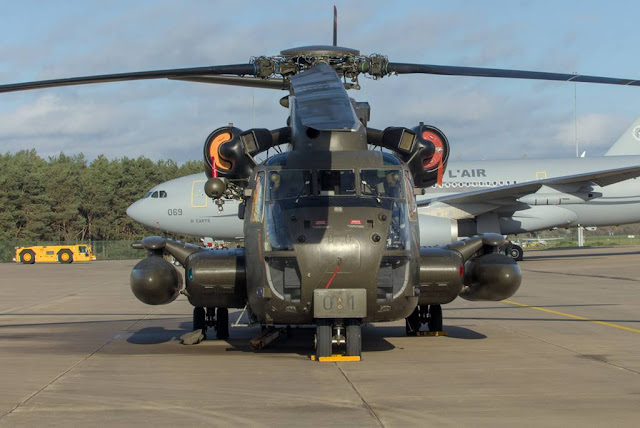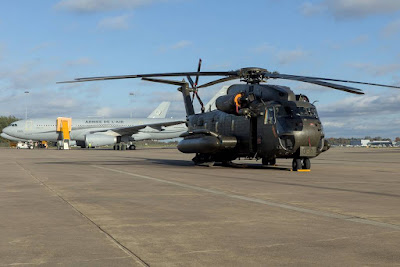EATC hosts first aeromedical evacuation day
 |
| German CH-53 helicopter sits parked on the flight line at Eindhoven Air Base, Netherlands. |
On Tuesday, November 7, 2033, the first Aeromedical Evacuation day was organized by EATC at Eindhoven Air Base (ICAO code EHEH). 'Aeromedical Evacuation' is the transport of injured people by air to a safer environment. EATC is a partnership of seven European countries: Belgium, France, the Netherlands, Germany, Italy, Luxembourg and Spain.
About 80 experts in the field of medical transport by air came together at Eindhoven air base. These were experts from the participating ETAC countries, but also from Denmark and the United States. There, the experts received an explanation about the possibilities and expertise that ETAC can offer in this area. The Aeromedical Evacuation procedures and challenges of the participants were then discussed.
The commander of EATC, Major-General Franck Mollard of the French Air Force, indicated in a speech that Aeromedical Evacuation is one of the 3 core tasks of EATC, in addition to air transport and refueling of aircraft in the air (air-air). refueling).
Aeromedical Evacuation is a major puzzle in which various countries have unique resources and capabilities. And all the pieces of the puzzle are put together by EATC, after which the right choice can be made for the required help.
Various aircraft and helicopters were positioned on the western platform of Eindhoven Air Base. All aircraft were equipped for 'Aeromedical Evacuation'.
EATC
EATC is a partnership of seven European countries: Belgium, France, the Netherlands, Germany, Italy, Luxembourg and Spain. These countries combine and optimize air transport in Europe. Where EATC acts as a broker between cargo that needs to be transported and transport aircraft that still have space on board. With the help of ETAC, the participating countries try to use air capacity as efficiently as possible.
For example, that
- the A330 MRTT (MMU unit) carries out an air-to-air refueling mission for Spanish fighter jets on behalf of the Netherlands
- a French C130J performs a parachute drop mission for Germany
- while a Belgian helicopter is transported by a Spanish A400M;
- a Luxembourgish Learjet performs an aeromedical evacuation for an Italian soldier injured in a crisis area
- an Italian C27J transporting French freight
- a Belgian A400M transports Dutch soldiers
- a German A400M performs an aeromedical evacuation mission off Luxembourg.
The participating countries use the ATARES system for settlement.
The "Air Transport & Air-to-Air Refueling and other Exchanges of Services" (ATARES) is a cashless exchange system for air transportation. Several European and NATO countries are part of the multinational ATARES agreement.
The exchange of services is based on the “Equivalent Flying Hour” (EFH): this reference is the cost of one (1) C-130 flight hour. All other aircraft types offered under the ATARES scheme are calculated based on this C-130 reference.
This arrangement facilitates mutual support through the exchange of services and is the currency used by the EATC Member States. This cashless service allows countries to save on outsourcing costs and optimize aircraft utilization (less empty space). It can also provide countries with additional training opportunities.
ATARES is not based on purely bilateral reciprocity, but must be seen in the global multinational framework.
EATC provides support to participating countries in three areas.
- Air transport
- Air-Air refueling
- Aeromedical Evacuation
The headquarters of EATC is based at Eindhoven air base.
About 80 experts in the field of medical transport by air came together at Eindhoven air base. These were experts from the participating ETAC countries, but also from Denmark and the United States. There, the experts received an explanation about the possibilities and expertise that ETAC can offer in this area. The Aeromedical Evacuation procedures and challenges of the participants were then discussed.
The commander of EATC, Major-General Franck Mollard of the French Air Force, indicated in a speech that Aeromedical Evacuation is one of the 3 core tasks of EATC, in addition to air transport and refueling of aircraft in the air (air-air). refueling).
Aeromedical Evacuation is a major puzzle in which various countries have unique resources and capabilities. And all the pieces of the puzzle are put together by EATC, after which the right choice can be made for the required help.
Various aircraft and helicopters were positioned on the western platform of Eindhoven Air Base. All aircraft were equipped for 'Aeromedical Evacuation'.
EATC
EATC is a partnership of seven European countries: Belgium, France, the Netherlands, Germany, Italy, Luxembourg and Spain. These countries combine and optimize air transport in Europe. Where EATC acts as a broker between cargo that needs to be transported and transport aircraft that still have space on board. With the help of ETAC, the participating countries try to use air capacity as efficiently as possible.
For example, that
- the A330 MRTT (MMU unit) carries out an air-to-air refueling mission for Spanish fighter jets on behalf of the Netherlands
- a French C130J performs a parachute drop mission for Germany
- while a Belgian helicopter is transported by a Spanish A400M;
- a Luxembourgish Learjet performs an aeromedical evacuation for an Italian soldier injured in a crisis area
- an Italian C27J transporting French freight
- a Belgian A400M transports Dutch soldiers
- a German A400M performs an aeromedical evacuation mission off Luxembourg.
The participating countries use the ATARES system for settlement.
The "Air Transport & Air-to-Air Refueling and other Exchanges of Services" (ATARES) is a cashless exchange system for air transportation. Several European and NATO countries are part of the multinational ATARES agreement.
The exchange of services is based on the “Equivalent Flying Hour” (EFH): this reference is the cost of one (1) C-130 flight hour. All other aircraft types offered under the ATARES scheme are calculated based on this C-130 reference.
This arrangement facilitates mutual support through the exchange of services and is the currency used by the EATC Member States. This cashless service allows countries to save on outsourcing costs and optimize aircraft utilization (less empty space). It can also provide countries with additional training opportunities.
ATARES is not based on purely bilateral reciprocity, but must be seen in the global multinational framework.
EATC provides support to participating countries in three areas.
- Air transport
- Air-Air refueling
- Aeromedical Evacuation
The headquarters of EATC is based at Eindhoven air base.
Photo: Joris van Boven
Text: Joris van Boven, Alex van Noije
Text: Joris van Boven, Alex van Noije



















No comments
All comments related to the contents of our articles are welcome. It is not allowed to post promotional messages, links to external sites, or references to activities not related to this blog.